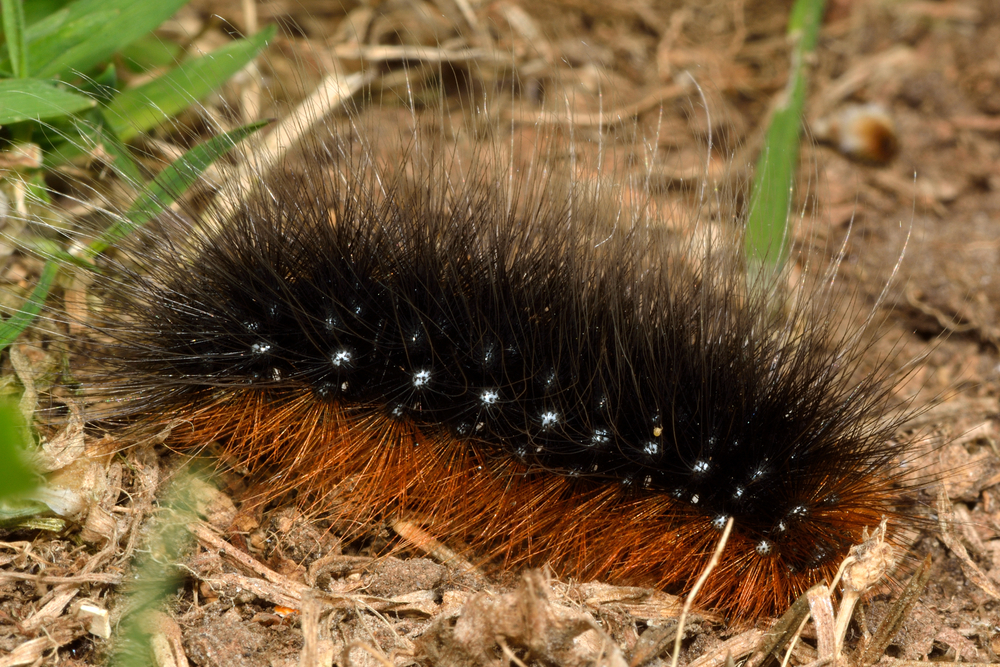The garden tiger moth is a striking species of insect found in the UK. Its vibrant wings feature bold, black and white stripes that stand out against its bright orange body, making it an impressive sight for any wildlife enthusiast. But there’s more to this remarkable creature than meets the eye; from where they live to what they eat and how long their life cycle lasts, let’s take a closer look at the garden tiger moth! We’ll explore all aspects of these fascinating moths’ lives, including their appearance, habitat preferences, diet choices and conservation status so you can learn everything you need to know about them.
Appearance
The garden tiger moth (Arctia caja) is a species of moth that can be found in Europe, Asia and North America. It has a wingspan of around 40-50mm, and its body length is usually between 20-25mm. The upper side of the forewings are typically bright orange or yellow with black spots along the edges while the underside is greyish brown with white patches. The hindwings have a similar pattern but are usually more muted in colouration than the forewings.
The caterpillar of this species has an impressive appearance; it ranges from green to pinkish purple with numerous tufts of hair on its back and sides as well as two long tails at either end. Its head is dark brown or black in colour, and it also features four pairs of prolegs which help it move around quickly when disturbed.

Habitat
The garden tiger moth prefers to inhabit open grasslands, meadows, and gardens with plenty of vegetation for it to feed on. This species can also be found near woodland edges or other areas where there are trees and shrubs.
Garden tiger moths prefer habitats that have an abundance of food sources such as nectar-producing flowers, fruit trees, and berry bushes. They may also be attracted to certain types of weeds like dandelions or clover. The caterpillars of this species feed on a variety of plants including nettles, thistles, willowherbs, docks and plantains.
In terms of climate preferences for the garden tiger moth’s habitat range from warm Mediterranean climates up to cooler boreal forests at higher altitudes. This species has been observed at elevations ranging from sea level up to 1 km above sea level in mountainous regions such as the Alps or Pyrenees mountains in Europe.
Diet
Adult garden tiger moths feed on nectar from flowers such as thistles, knapweeds, hawkbits and dandelions. They also feed on honeydew produced by aphids or other insects.
The caterpillars of the garden tiger moth have an interesting diet that consists mostly of plants like stinging nettles, docks, plantains and willowherbs but they can also eat fungi or lichens if necessary. In some cases they may even consume dead animals or carrion when food is scarce. The caterpillars are often seen feeding during the day in groups which helps them to avoid predators such as birds more effectively than if they were alone.
The garden tiger moth has a wide variety of food sources, including wildflowers, trees and shrubs. Next, let’s take a look at its life cycle to learn more about this fascinating species.
Life Cycle
The life cycle of the garden tiger moth begins with an egg. The eggs are laid in clusters on leaves and stems of plants, usually near the ground. After hatching from their eggs, larvae emerge as small caterpillars. These caterpillars have a distinctive black-and-white striped pattern and feed on a variety of plant species including nettles, docks, thistles and willowherbs. As they grow larger they moult several times until reaching full size at around 4 cm long.
At this stage the larva enters its pupal phase where it forms a cocoon for protection while undergoing metamorphosis into an adult moth. This process takes about two weeks before emerging as a fully formed adult garden tiger moth with its characteristic orange wings marked with black spots and stripes along each edge.
Once emerged from its cocoon, the adult garden tiger moth has only one goal: to reproduce! They mate soon after emergence in late summer or early autumn before entering hibernation during winter months when food is scarce or temperatures drop too low for them to survive outdoors. In springtime adults become active again to lay eggs which start the cycle anew!

Conservation Status
In terms of conservation status, the garden tiger moth is listed as Least Concern by the International Union for Conservation of Nature (IUCN). This means that it does not face any immediate threats to its survival in nature.
FAQs
Is a garden tiger moth poisonous?
No, the garden tiger moth (Arctia caja) is not poisonous. This species of moth is harmless to humans and other animals. It has a unique defense mechanism in which it releases an unpleasant odor when disturbed or threatened. The bright colors of its wings also act as a warning signal to potential predators that it may be distasteful or toxic. While the garden tiger moth is not poisonous, it should still be handled with care as its wings can be easily damaged.
Is a garden tiger moth rare in yhe UK?
Once a very common UK moth, their numbers have been declining since the 1980s due to habitat loss and climate change, making them increasingly difficult to find.
Where can you find a garden tiger moth?
The garden tiger moth is a species found in gardens and woodlands across the UK. They can be seen from late spring to early autumn, often resting on flowers during the day or flying around at night. They are attracted to light sources such as street lamps and porch lights, so these may be good places to look for them. Garden tiger moths are also commonly spotted near ponds or damp areas where they feed on nectar from plants like nettles and thistles.

Ash is a contributing author who has been writing about wildlife for as long as he can remember. He has a vast knowledge of many different types of animals, from the tiniest shrews to the great whales that live in the deepest oceans.

We have a garden tiger moth in our sideway. It is fairly inactive but alive. We are in Southwold in Suffolk. It’s amazing looking. Presumably best to leave it alone ?
Yes, best to leave it be.
I found a rather drab looking moth on my front porch. I didn’t see it at first and almost stepped on it. I nudged it with my finger to move it out of the way and it opened it’s wings to reveal the most beautiful, amazing and multicolored creature I have ever seen. I let it crawl on my finger and held it up in the air and it flew away. I have a picture and a little video of it. I hope it lives on….